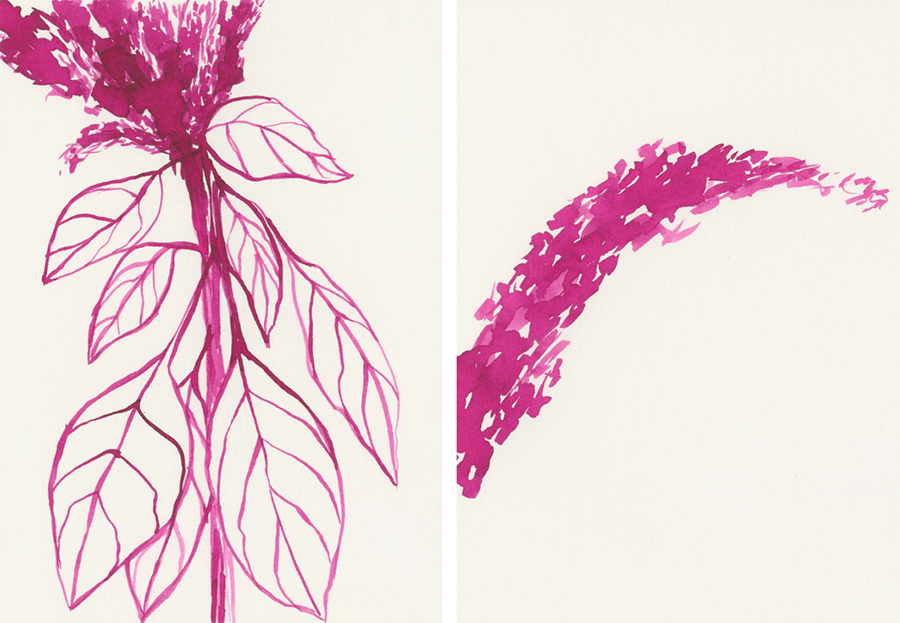
Field Drawings, courtesy of the artist.
Julia Mensch (AR/CH)
Field Drawings, part of Amaranth as Political Agent, 2023–2025
Drawings, ink on paper., 2023-2025
The context of the “AMARANTH AS POLITICAL AGENT” research project is the implementation of the neo-extractivist model of transgenic agriculture in Argentina since 1996, when the first GM (genetically modified) crop was released for commercialization in Latin America: the 40-3-2 Roundup Ready soybean from Monsanto (today Bayer), resistant to the herbicide glyphosate. In the research, this model is understood as a continuation of the terricide that began with Spanish colonization, and exacerbates Latin America’s condition as an exporter of Nature, initiated in 1492.
This project takes amaranth, a plant native to the Americas, as a companion: its seeds were preserved by indigenous peoples despite Spanish colonizers’ prohibition, and today, it is the most paradigmatic glyphosate-resistant weed for the monoculture model. Transgenic agriculture promised to exterminate weeds with the use of glyphosate, but today, there are 28 wild plants resistant to the herbicide. Amaranth alone grows undisciplined in 25 million hectares of GM crops, being resistant not only to glyphosate but to most of the agro-toxins used in transgenic agriculture. Amaranth may well be, as Dr. Carrasco called it, “America’s revenge”.
Kiwicha, part of Amaranth as Political Agent, 2023–2025
Video by Julia Mensch, song by Sofía Viola, 2023-2025
The desire to sing to a plant brought this song into being, along with the intuition that Sofía Viola would be the one to know how to do it. Mensch shared her research with the singer, who planted amaranth in her home to observe its growth during the Argentine spring and summer. Drawing on her close observations of the plant’s behavior and the insights from Mensch’s research, Viola composed the song.
Julia Mensch is a visual artist from Buenos Aires based in Berlin. She studied at Hito Steyer’s class at the UdK, Berlin, and at the National Art University in Buenos Aires. Currently, she is a PhD Candidate for the SNF research project “Plants_Intelligence. Learning Like a Plant,” hosted by IAGN HGK Basel FHNW and the Bauhaus-University Weimar. Her practice focuses on the history of Socialism and Communism, as well as environmental sociopolitical conflicts in Latin America. She has been granted and exhibited internationally, including at Savvy Contemporary (Berlin), Museo Nacional de Grabado (Buenos Aires), Shedhalle (Zurich), and the Sesc_Videobrasil art biennial (São Paulo).
This artwork is realized within the framework of the research project Plants_Intelligence. Learning Like a Plant (2022–2025). A research project by Yvonne Volkart, Felipe Castelblanco, Julia Mensch, and Rasa Smite. Funded by the Swiss National Science Foundation (SNSF) and hosted by the Institute Art Gender Nature, Basel Academy of Art and Design FHNW.

Field Drawings, courtesy of the artist.
Hūlija Menša (AR/CH)
Lauka zīmējumi
zīmējumi, tuša uz papīra, 2023-2025
Zīmējumi sākti Argentīnas ģenētiski modificēto kultūraugu laukos – vietās, kur savvaļas amarants aug kopā ar kultivētajiem augiem – un turpināti studijā. Šajā projektā zīmēšana ir domāšanas un vērošanas veids, kas palēnina laiku un asinina uzmanību, nepaļaujoties uz tehnoloģijām. Rīkojoties lēnāk, mākslinieks pastiprina uztveri par augu uzvedību un savvaļas augu vēsturisko un politisko dinamiku.
Šis darbs ir daļa no pētniecības projekta “Amarants kā politisks aģents”, kas pēta neoekstraktivisma modeli transgēnās lauksaimniecības jomā Argentīnā kopš 1996. gada, sākot ar “Monsanto Roundup Ready” sojas pupām. Projektā amarants, Amerikas kontinentam raksturīgais augs, tiek uztverts kā pavadonis: reiz saglabāts indiāņu rokās, neskatoties uz koloniālo aizliegumu, tas tagad plaukst kā glifosāta izturīgs nezāļu augs, simbolizējot ekoloģiskās un politiskās spriedzes monokultūru lauksaimniecībā.
Darbs tapis pētnieciskā projekta Augu_intelekts. Mācoties kā augam (2022–2025) ietvaros.
Pētniecības projekta autori: Ivonna Volkarta, Felipe Kastelblanko, Hūlija Menša un Rasa Šmite.
Projekts finansēts ar Šveices Nacionālā Zinātnes fonda (SNSF) atbalstu un īstenots Bāzeles Mākslas un dizaina akadēmijas (FHNW) Institūtā Art Gender Nature.